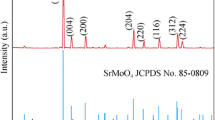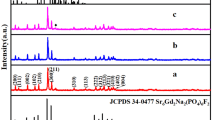Abstract
A series of novel orange-red Sr1.9RE8(SiO4)6O2:0.1Eu(2+,3+) (RE = Y, Gd, La) phosphors were synthesized by high-temperature solid-phase reaction method, all of which are apatite structure, belonging to hexagonal crystal system. The cell parameters (a, c) and cell volume (V) of Sr1.9RE8(SiO4)6O2:0.1Eu(2+,3+) decrease with the substitution of RE3+ by La3+, Gd3+ and Y3+, respectively, and the crystal size decreases from 64.8309 to 49.0382 nm. The excitation spectra of Sr1.9RE8(SiO4)6O2:0.1Eu(2+,3+) phosphors are a broadband in the range of 200–600 nm, which can be attributed to the CTS of Eu3+ and the d–f transition of Eu2+. When RE3+ in the matrix is replaced by La3+, Gd3+ and Y3+, respectively, the charge transfer band of Eu3+ generates bathochromic shift from 265 to 275 nm, and the broadband of the excitation spectrum of Eu2+ is red shifted from 320.5 to 336 nm. The emission spectra of Sr1.9RE8(SiO4)6O2:0.1Eu(2+,3+) phosphors in the range of 500–750 nm are a set of strong sharp line spectra, which are inconsistent with emission broadband spectrum of Eu2+ allowing electric dipole transition, mainly including the transition of 5D0, 5D1, 5D2 → 7FJ from Eu3+. This result indicates that Eu2+ can efficiently transfer energy to Eu3+ and Sr1.9La8(SiO4)6O2:0.1Eu(2+,3+) exhibits the highest transfer efficiency. Importantly, the color coordinates of Sr1.9RE8(SiO4)6O2:0.1Eu(2+,3+)(RE = Y, Gd, La) are all in the orange-red light range, and the color temperature is lower than 1800 K with a high color rendering index (CRI ≥ 75), which is suitable for the phosphor of white LED excited by UV chip.












Similar content being viewed by others
References
Chen J, Zhang N, Guo C, Pan ZX, Suo H, Zhao X, Goldys EM (2016) Site-Dependent luminescence and thermal stability of Eu2+ doped fluorophosphate toward white LEDs for plant growth. ACS Appl Mater Interfaces 8:20856–20864. https://doi.org/10.1021/acsami.6b06102
Chubert EFS, Kim JK (2005) Solid-state light sources getting smart. Science 308:1274–1278. https://doi.org/10.1126/science.1108712
Ci Z, Que M, Shi Y, Zhu G, Wang Y (2014) Enhanced photoluminescence and thermal properties of size mismatch in Sr2.97-x-yEu0.03MgxBaySiO5 for high-power white light-emitting diodes. Inorg Chem 53:2195–2199. https://doi.org/10.1021/ic402859s
EL HuangYG H, Deng MY, Wu ST (2020) Mini-LED, Micro-LED and OLED displays: present status and future perspectives. Light Sci Appl 9:105. https://doi.org/10.1038/s41377-020-0341-9
Genç M, Sheremet V, Elçi M, Kasapoğlu AE, Altuntaş İ, Demir İ, Eğin G, İslamoğlu S, Gür E, Muzafferoğlu N, Elagöz S, Gülseren O, Aydınlı A (2019) Distributed contact flip chip InGaN/GaN blue LED; comparison with conventional LEDs. Superlattice Microst 128:9–13. https://doi.org/10.1016/j.spmi.2019.01.008
Kondo Y, Tanaka K (2005) Time-resolved study of luminescence in soda-lime silicate glasses co-doped with Gd3+ and Eu3+. Opt Mater 27:1438–1444. https://doi.org/10.1016/j.optmat.2004.10.007
Konstantin VI, Shi QF, Bettinelli M, Pustovarov VA (2018) Unraveling Pr3+ 5d–4f emission in LiLa9(SiO4)6O2 crystals doped with Pr3+ ions. Opt Mater 79:108–114. https://doi.org/10.1016/j.optmat.2018.03.006
Li K, Fan J, Shang MM, Lian HZ, Lin J (2015) Sr2Y8(SiO4)6O2:Bi3+/Eu3+:a single-component white-emitting phosphor via energy transfer for UV w-LEDs. J Mater Chem C 3:9989–9998. https://doi.org/10.1039/C5TC01993A
Liu WR, Lei B (2018) Thermal stability study of BaAl2Si2O8:Eu2+ phosphor using its polymorphism for plasma display panel application. J Nanosci Nanotechnol 18:374–380. https://doi.org/10.1166/jnn.2018.14565
Masubuchi Y, Higuchi M, Takeda T, Kikkawa S (2006) Oxide ion conduction mechanism in RE9.33(SiO4)6O2 and Sr2RE8(SiO4)6O2 (RE = La, Nd) from neutron powder diffraction. Solid State Ion 177:263–268. https://doi.org/10.1016/j.ssi.2005.09.015
Mercier F, Alliot C, Bion L, Thromat N, Toulhoat P (2006) XPS study of Eu(III) coordination compounds: core levels binding energies in solid mixed-oxo-compounds EumXxOy. J Electron Spectros Relat Phenom 150:21–26. https://doi.org/10.1016/j.elspec.2005.08.003
Moreno I, Viveros-Méndez PX (2021) Modeling the irradiation pattern of LEDs at short distances. Opt Express 29:6845–6853. https://doi.org/10.1364/OE.419428
Nakamura S, Mukai T, Senoh M (1994) Candela-class high-brightness InGaN/AlGaN double-hetero structure blue-light-emitting diodes. Appl Phys Lett 64:1687–1689. https://doi.org/10.1063/1.111832
Ohno K, Abe T (1986) Effect of BaF2 on the synthesis of the single-phase cubic Y3Al5O12:Tb. J Electrochem Soc 133:638. https://doi.org/10.1149/1.2108635
Shannon RD (1976) Revised effective ionic radii and systematic studies of interatomic distances in halides and chalcogenides. Acta Cryst A32:751–767. https://doi.org/10.1107/S0567739476001551
Vercaemst R, Poelman D, Fiermans L, Thromat N, Toulhoat P (1995) A detailed XPS study of the rare earth compounds EuS and EuF3. J Electron Spectros Relat Phenom 74:45–56. https://doi.org/10.1016/0368-2048(95)02349-6
Wang YH, Wu CF, Wei J (2007) Hydrothermal synthesis and luminescent properties of LnPO4: all of Tb, Bi(Ln=La, Gd)phosphors under UV/VUV excitation. J Lumin 126:503–507. https://doi.org/10.1016/j.jlumin.2006.09.006
Wang J, Lin H, Huang Q, Xiao G, Xu J, Wang B, Hua T, Wang Y (2017) Structure and luminescence behavior of a single-ion activated single-phased Ba2Y3(SiO4)3F: Eu white-light phosphor. J Mater Chem C 5:1789–1797. https://doi.org/10.1039/C6TC04350J
Wang F, Tian YG, Zhang Q (2019) Synthesis, crystal structure and luminescent properties of Sr0.955Al2-xBxSi2O8: Eu2+ phosphors for white LED. Chin J Inorg Chem 35:1085–1092
Wegh RT, Donker H, Meijerink A (1997) Vacuum-ultraviolet spectroscopy and quantum cutting for Gd3+ in LiYF4. Phys Rev B 56:13841–13848. https://doi.org/10.1103/PhysRevB.56.13841
Zhang J, Zhou BB, Wang XC (2016) Investigations on photoluminescence and cathodoluminescence properties of Ca3La6(SiO4)6:Tb(3+), Mn(2+). Spectrochim Acta A 165:85–89. https://doi.org/10.1016/j.saa.2016.04.029
Zhang ZW, Wang LJ, Yang SS, Chen WG, Chu XJ (2017) Synthesis and characterizations of novel Ba2La8(SiO4)6O2: Eu3+ oxyapatite phosphors. Dyes Pigm 142:272–276. https://doi.org/10.1016/j.dyepig.2017.03.048
Zhang YY, Bin JX, Mei LF, Huang ZH (2019) Synthesis and luminescence properties of reddish orthosilicate oxyapatite phosphor LiGd9(SiO4)6O2:Sm3+. J Lumin 206:645–648. https://doi.org/10.1016/j.jlumin.2018.10.043
Acknowledgements
This work was supported by grants from Science and Technology Innovation Project of Nanjing Military Region (15MS050), the Key projects of the Department of Education of Anhui Province (KJ2016A893, KJ2019A0888), the quality engineering project of Anhui Education Department (2018mooc112), the Support Project for Outstanding Young talents in Colleges and Universities of Anhui Province(gxyq2018126), the scientific research project of Anhui Sanlian University (KJZD2021009, KJZD2018004, 2015Z001, 2013Z001).
Author information
Authors and Affiliations
Corresponding author
Additional information
Publisher's Note
Springer Nature remains neutral with regard to jurisdictional claims in published maps and institutional affiliations.
Supplementary Information
Below is the link to the electronic supplementary material.
Rights and permissions
About this article
Cite this article
Wang, F., Chen, H. & Zhang, S. Preparation and luminescent properties of a novel orange-red phosphor Sr2RE8(SiO4)6O2:Eu(2+,3+) (RE = Y, Gd, La) for LEDs. Chem. Pap. 75, 5803–5811 (2021). https://doi.org/10.1007/s11696-021-01770-0
Received:
Accepted:
Published:
Issue Date:
DOI: https://doi.org/10.1007/s11696-021-01770-0




